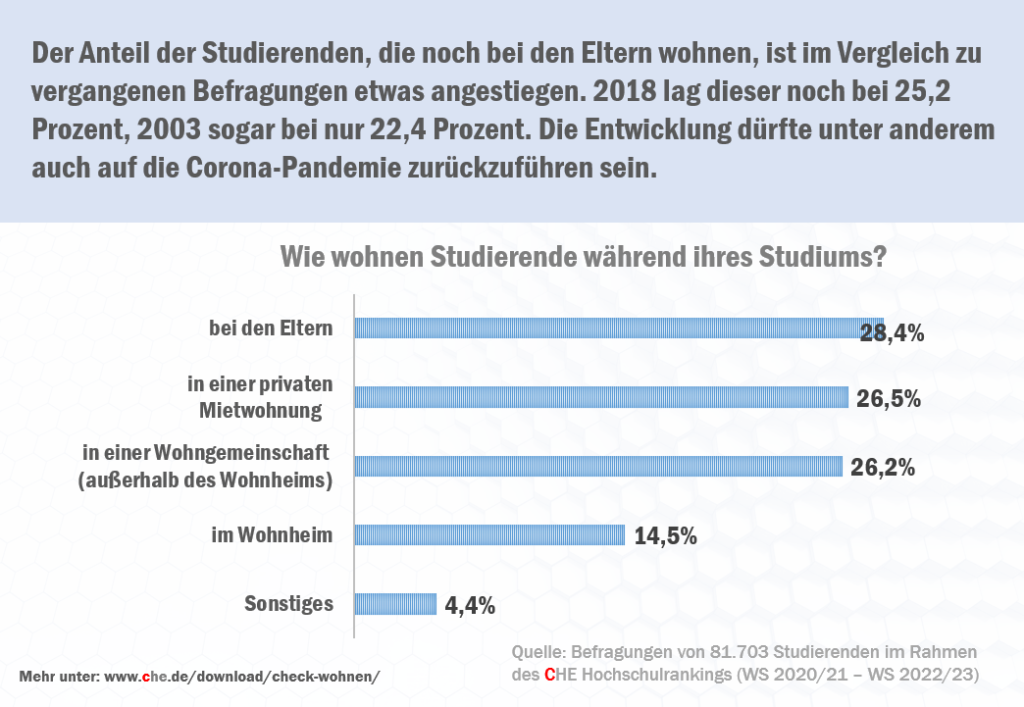 Foto: Pixabay
Foto: PixabayThe housing situation of students, whether they live in rental apartments, shared flats or the parental home, differs greatly from region to region in Germany. The colloquially known “Hotel Mum” is particularly popular in Saarland, whereas the highest proportion of students living in shared flats can be found in Thuringia. One in twelve students lives at least 50 kilometres away from their place of study, and one-third of students regularly cycle to university. These are the findings of the latest CHECK on the housing situation and mobility of students in Germany conducted by the CHE Centre for Higher Education.
As part of the CHE University Ranking, around 80,000 students answered questions related to their housing situation and how they get to university. The largest proportion of students (28.4%) currently still live with their parents, and around one-quarter each reside in a private rental apartment or shared flat (26.5 and 26.2%). Comparing the situation between women and men, male students are more likely than their female counterparts to be living in the parental home, whereas female students tend to opt for a private rental apartment or shared flat.
There are major differences in the student housing situation at the regional level, depending on the university location. In Saarland, for instance, 42.9 per cent of students still use “Hotel Mum””, whereas Thuringia is Germany’s federal state with the highest proportion of students living in shared flats (34.5%). Friedrichshafen is the city that tops the list when it comes to the proportion of students living in shared flats. In this university city, three-quarters of the respondents stated that they lived in a shared flat that was not part of a hall of residence. (An interactive presentation of the housing situation and mobility of students for 163 university locations in Germany can be found in the accompanying CHE DataCHECK at hochschuldaten.de – LINK)


“Above all, students of universities of applied sciences and vocational academies based in small cities and municipalities are more likely than average to be still living with their parents. Shared apartments, on the other hand, are particularly popular in medium-sized university cities,” stated the author of the study Marc Hüsch, highlighting striking features of the analysis of residential arrangements. “No doubt the unique challenges posed by the Covid-19 pandemic also play a role,” remarked Hüsch. After all, survey data from the winter semesters 2020/21, 2021/22 and 2022/23 was taken into account for the analysis.
The impact generated by the Covid-19 pandemic must also be taken into account with regard to choices of residence. More than 60 per cent of all students in Germany currently live in the city where they study. The main place of residence of 28.9 per cent of students is within a radius of up to 50 kilometres from campus. One in twelve students has to travel more than 50 kilometres to get to university. Whereas around eight per cent currently have such a long journey, this figure was only six per cent in the last evaluation in 2018.
Many students use sustainable means of transport to get to university. More than half regularly use public transport. Only one-quarter of the respondents regularly resort to using a car or motorbike to travel to and from university.
The proportion of students who cycle to university is particularly high in Greifswald (88.8 %), Münster (78.0 %) and Göttingen (73.6 %). Public transport is commonly used by students to get to university, especially in the cities of Hamburg and Berlin. In Thuringia, more than half of all students walk to university, while in Saarland the majority of students regularly use a car.
About the publication:
The “CHECK – Wohnsituation und Mobilität von Studierenden in Deutschland 2023” (CHECK – The housing situation and mobility of students in Germany 2023) was based on survey data compiled as part of the CHE University Ranking. The CHE University Ranking in the ZEIT Study Guide and the new ZEIT portal Hey Studium is the most comprehensive ranking of German universities and universities of applied sciences. In the winter semesters 2020/21, 2021/22 and 2022/23, 82,002 students (from the 3rd semester or higher) on undergraduate degree programmes covering more than 40 subjects answered questions about their housing situation and/or mobility at university. The respondents come from 326 different higher education institutions and vocational academies. Parallel to the publication of the CHECK, the CHE Portal www.hochschuldaten.de presents an accompanying DataCHECK containing interactive charts with detailed information from the survey for 163 university locations in Germany. Marc Hüsch wrote both publications.
CHECK - Wohnsituation und Mobilität von Studierenden in Deutschland 2023 15. June 2023 3.16 MB 20867 downloads
Hüsch, Marc: CHECK - Wohnsituation und Mobilität von Studierenden in Deutschland...DatenCHECK 3/2023: Wohnsituation und Mobilität bei Studierenden an einzelnen Hochschulorten in Deutschland 15. June 2023 0.00 KB 17282 downloads
Hüsch, Marc: DatenCHECK 3/2023: Wohnsituation und Mobilität bei Studierenden an...
Bildquelle: Pixabay
